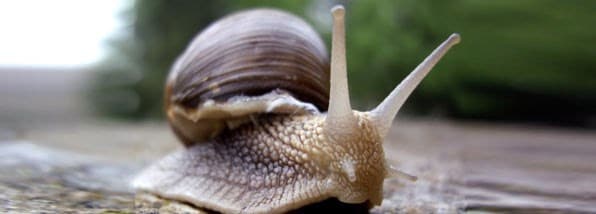How to deal with slugs and snails
Slugs and snails seem to lie in wait for the unwary gardener. No sooner have the first tender young shoots emerged in spring or new bedding been planted, than the tell-tale signs of feasting slugs and snails are noticed: irregularly shaped holes in leaves and sparkling slime trails criss-crossing newly planted beds. Slugs and snails will attack any soft growth, with a particular liking for lush plants such as hostas. They are the number one and number two pests in most gardens, particularly where there are lots of luscious plants as well as damp soil that’s manured.
Slugs or snails? You can tell whether your problem is slugs or snails (or both!) by the type of damage and where it occurs. Both leave slime trails, but snails are surprisingly good at scaling vertical surfaces and other obstacles, so if you have something demolishing your plants in a hanging basket it’s probably a snail. Snails also tend to be a bit fussy about what they eat, often feasting on the softer tissues between ribs of a leaf, leaving tell-tale skeletonised remains. Slugs, on the other hand, tend to stay around ground level and simply eat everything within rasping distance. Keeled slugs actually live underground, eating roots and tubers. Common in damp soils that are rich in organic matter, they’ll ruin crops of potatoes by tunneling into them and eating out large holes.
Control measures
The traditional remedy of liberally scattering slug pellets across the garden is rejected by most gardeners these days on the grounds of environmental responsibility and safety, so what can you do about these delinquent pests? If you are cunning you can catch these creatures before they totally destroy your vulnerable plants without risking other wildlife.
Nocturnal patrols.
Slugs and snails feed at night, so if you go out with a torch and pick them off those plants that are most likely to be under attack, you will be able to catch them.
Rough barrier.
It is often recommended to surround vulnerable plants with material that is uncomfortable for them to cross such as sharp grit or broken egg shells. You need to make sure that the barrier is at least 5cm wide and there are no gaps.
Salt barrier
Plants in pots can be protected by greasing the rim with Vaseline mixed with salt. As they slither up the side of the pot they take up the salt which dehydrates them. Any slugs found away from plants can be treated directly using salt.
Food and drink.
Buried jars of beer are irresistible to slugs and snails and they usually leave plants alone and head for the beer, they fall in, can’t escape and drown. Slugs also love to eat bran and will happily gorge themselves on it. The bran then swells in their stomach and they explode. It’s less effective on snails.
Copper rings.
You can now get copper strips to tape around pots. It is claimed that these emit a small electrical charge, which will shock the slugs and snails if they try to cross. Copper rings are also available to place around the base of more precious specimens like Delphiniums or Hostas.
Other remedies.
There is also an old wives tale that if you stew the slugs you have caught in water and then pour the resulting mixture around vulnerable plants it is quite a good deterrent – but it revolting! An alternative is to spray on a yucca extract which is thought to have a similar effect.
Biological control

You can buy nematodes (microscopic worm-like creatures), which aggressively search out and attack slugs. They enter the slug’s body through a hole behind their heads. Once inside they release a bacterium which stops the slug eating. The nematodes then start to reproduce inside and within 7-10 days the slug is dead. The nematodes continue to reproduce as the body breaks down. This new population enters the soil and searches out new slugs to attack. This is a natural, non-toxic control method that is safe for both users and wildlife. The nematodes stay active for 6 weeks so a single dose protects plants when they are emerging in the spring and are most vulnerable. Nematodes can only be used in spring and summer when the soil is warm. They represent the best method of controlling underground keel slugs which rarely come to the surface.
Chemical control
Slug pellets are effective but they can lead to the death of hedgehogs and thrushes which ingest poisoned molluscs. And if they were completely effective, would gardeners who use them have to continue to do so on a regular basis?
Check it’s not caterpillars
Caterpillars can often damage leaves and new growth in a similar way to slugs and snails. If there are no slime trails, check for frass (tiny black balls of excrement) that caterpillars leave behind. If you spot large numbers of caterpillars, pick them off by hand or if inaccessible, try spraying them off with a powerful jet of water from a hose. Solitary caterpillars on ornamental plants are best left alone since they will cause minimal damage.





